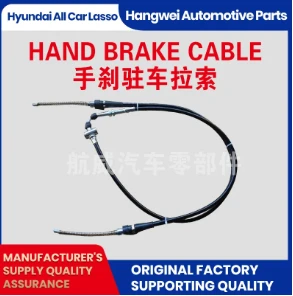e brake cable
Understanding the E-Brake Cable A Critical Component in Vehicle Safety
In the realm of automotive engineering, safety is paramount, and one of the often-overlooked components that contribute significantly to vehicle safety is the e-brake cable, also known as the emergency brake cable. This relatively simple yet essential assembly plays a critical role in the functionality of a vehicle's parking brake system. In this article, we will dive into the roles, maintenance, and importance of the e-brake cable.
What is the E-Brake Cable?
The e-brake cable is part of the emergency brake or parking brake system, designed to keep a vehicle stationary when parked. Unlike the primary braking system, which is hydraulic and designed to stop the vehicle while in motion, the e-brake system provides a manual method to hold the car in place. The e-brake cable connects the handbrake lever or pedal inside the car to the rear brake assembly, often involving either drum or disc brakes.
The typical structure of an e-brake cable includes a metal wire encased in a protective sheath. When the driver pulls the handbrake lever or pushes the e-brake pedal, it pulls the cable, activating the brakes and locking the wheels. This mechanism ensures that the vehicle remains secure, especially on inclines or uneven surfaces.
Importance of E-Brake Cables
1. Safety and Security One of the most crucial functions of the e-brake cable is to ensure the vehicle remains immobilized when parked. This aspect is particularly critical in hilly areas where even a slight incline could cause a vehicle to roll away, posing a danger to pedestrians, other vehicles, and property.
2. Reliability E-brake cables are designed to withstand significant wear and tear. Over time, however, exposure to the elements—such as moisture, dirt, and extreme temperatures—can lead to corrosion and deterioration. A reliable e-brake cable is vital for the overall functioning of the emergency brake, making it a key concern for vehicle owners.
3. Legal Requirements In many jurisdictions, functional parking brakes are legally mandated. Failing to have a properly functioning e-brake cable could not only result in an unsafe driving situation but could also lead to legal repercussions, including fines and liability in accidents.
e brake cable

Maintenance of E-Brake Cables
To ensure the longevity and effectiveness of an e-brake cable, regular maintenance is essential. Here are some tips for keeping this critical component in good shape
- Visual Inspections Regularly check the e-brake cable for signs of wear, fraying, or corrosion. The protective sheath should be intact without any cracks or openings, as these can allow moisture and dirt in, leading to premature failure.
- Lubrication Periodically lubricate the cable to prevent rust and ensure smooth operation. Use a specialized brake cable lubricant to avoid attracting dirt and dust, which can hinder the cable's performance.
- Check Adjustments The parking brake mechanism may require adjustments over time to ensure it engages and disengages smoothly. If the e-brake lever feels loose or has too much travel, it may be time to have it adjusted or replaced.
- Professional Inspections Consider scheduling regular maintenance with a professional mechanic who can check the entire braking system, including the e-brake cable, to ensure everything is functioning properly.
Conclusion
The e-brake cable is a small yet vital part of your vehicle’s braking system that should not be underestimated. By understanding its function and importance, vehicle owners can proactively ensure their safety and compliance with regulations. Regular maintenance and inspections can greatly extend the life of the e-brake cable and enhance overall vehicle reliability. Taking the time to care for this important component not only protects the vehicle but also ensures peace of mind for the driver and others on the road. Remember, a well-maintained e-brake system is not just an option; it’s a necessity for safe driving.
-
Workings of Clutch Pipe and Hose SystemsNewsJun.04,2025
-
The Inner Workings of Hand Brake Cable SystemsNewsJun.04,2025
-
The Secrets of Throttle and Accelerator CablesNewsJun.04,2025
-
The Hidden Lifeline of Your Transmission Gear Shift CablesNewsJun.04,2025
-
Demystifying Gear Cables and Shift LinkagesNewsJun.04,2025
-
Decoding Clutch Line Systems A Comprehensive GuideNewsJun.04,2025
